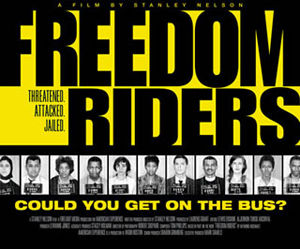(ThyBlackMan.com) Whatever you plan to do today (May 16), make sure you are home in front of the television or have set your recorder to tape Freedom Riders, the excellent PBS documentary by filmmaker Stanley Nelson. And make sure children, related or unrelated, watch the documentary with you.
For nearly two dramatic and informative hours, Nelson recaptures the 1961 Freedom Riders that desegregated interstate transportation in the South. I was in the 8th grade when the Freedom Rides took place, too young to have been on the buses headed South, but old enough to understand the courage African-Americans and Whites displayed in forcing America to live up to its  professed ideals.
professed ideals.
In 1955, the Interstate Commerce Commission issued a ruling in Sarah Keys v. Carolina Coach Company rejecting separate but equal accommodations in interstate travel. Five years later, in Boynton v. Virginia, the U.S. Supreme Court outlawed racial segregation in the waiting rooms and buses that were part of interstate travel.
Although the law was on the books, it was not enforced by the federal government and certainly not by local law enforcement officers in the Deep South, many of whom were members of the Ku Klux Klan. Led by the Congress of Racial Equality (CORE), a movement was created to change that situation.
Freedom Riders, many of them college students, say over and over in the documentary that not only were they prepared to die, if necessary, but they expected to be killed on those daring rides through the South. They were attacked my mobs wielding baseball bats, iron chains and other dangerous objects.
In contrast to today, when even some self-described liberals question the value of affirmative action or falsely assert that we live in a post-racial society, many Whites joined the Freedom Rides, knowing KKK members would single them out for extra punishment.
There is a famous photograph of James Peck, a White man, beaten in Birmingham, Ala. He suffered a broken nose, his forehead was bandaged and he looked like a mummy beaten to a pulp. It took more than 50 stitches to close wounds to his head. There is also a photo of Jim Zwerg, also White. Dressed in a suit and tie, blood was splattered all over his pummeled body.
No one stood out more than Diane Nash, a young Fisk University student organizer. She was joined by John Lewis, a young seminary student and future Congressman. He was badly beaten by a White mob in Birmingham and again several years later in the Selma-to-Montgomery March. “I was like a solider in a non-violent army,” John Lewis recalled in the documentary. “I was ready.”
When John Seigenthaler, an aide to Attorney General Robert F. Kennedy, tried to brow-beat Nash into calling off Freedom Rides that originated in Nashville, she politely told him: “Sir, you should know that we all signed our last will and testament last night.”
There was no turning around.
When the Greyhound and Trailways buses departed Washington, D.C. on May 4, 1961, the goal was to challenge segregated seating on interstate buses as well as the “White Only” waiting areas in bus stations throughout South. The rides were to culminate with a rally in New Orleans on May 17, the anniversary of the 1954 Brown v. Board of Education Supreme Court decision.
One of the most remarkable things about the movement was that every time Freedom Riders were viciously attacked and it appeared that violent mobs had gained the upper hand, another wave of buses would hit the road. In all, more than 400 Americans took part in the Freedom Rides, converging on Alabama and Mississippi to make their point.
The photograph of a burning Greyhound bus near Anniston, Ala., 120 miles from my hometown of Tuscaloosa, is an image that I will carry to my grave. Nelson takes us back to May 14, 1961 – Mother’s Day – when Ku Klux Klansmen slashed the tires of the bus, forcing it to stop just outside of the city. The mob had followed the bus in their cars. When the bus was forced to stop, they firebombed it and blocked the door in hopes of forcing the Freedom Riders to die in the inferno. It was only after highway patrolmen determined the Klansmen had had enough “fun” and fired into the air that the mob was dispersed and Freedom Riders allowed to disembark.
Rev. Fred Shuttlesworth, the fearless civil rights leader from Birmingham, organized several carloads of Blacks to rescue the stranded Freedom Riders.
Where were law enforcement officials?
In most cases, they were part of the mobs or, as was the case in Birmingham, entered into an agreement with local Klansmen to giving them 15 minutes of free reign before police would move in and arrest the Freedom Riders on an assortment of charges, including disorderly conduct and violating Jim Crow laws.
President John F. Kennedy and his brother, Robert, behaved in a despicable manner. Instead of upholding the Supreme Court decision that ordered desegregation in interstate travel or an ICC mandate that did likewise, the Kennedy brothers were strongly urging Freedom Riders to end their protests.
Attorney General Robert F. Kennedy said at the time, “I don’t question their legal right to travel, but I question their wisdom. Some people can get hurt.” He neglected to point that as the nation’s highest law enforcement official, it was his duty to protect their right to travel anywhere in the U.S.
As Stanley Nelson shows in the documentary, the Kennedy brothers made a secret deal with segregationist Mississippi Gov. Ross Barnett that if he would keep the mobs away, the federal government would not interfere with his arresting Freedom Riders when they arrived in the state. Barnett told Whites to stay home and they complied. When the Freedom Riders arrived in Mississippi, they were sent to the notorious Parchman Prison Farm.
Again, the Freedom Riders refused to be outsmarted. They sent out the call for busloads of riders to head to Jackson, Miss. as part of a successful plan to fill up the jails and prisons. Because of their persistence, the Kennedys were forced to begin protecting the rights of interstate travelers.
The story of the Freedom Riders is one of courage and a commitment to equality. Through his documentary, Stanley Nelson reminds us of a period when many Americans were willing to risk their lives to fight injustice. The documentary is also a challenge for us to rekindle that lost fervor.
Written By George Curry
Official website; http://www.GeorgeCurry.com

















I saw it. It was stunning. It really seemed to capture the Freedom Riders struggle and put it in the context of the unfolding Civil Rights movement. This film has to stand alongside the Eyes on the Prize and the film, Martin Luther King: From Montgomery to Memphis as landmark cinematic documentary history.